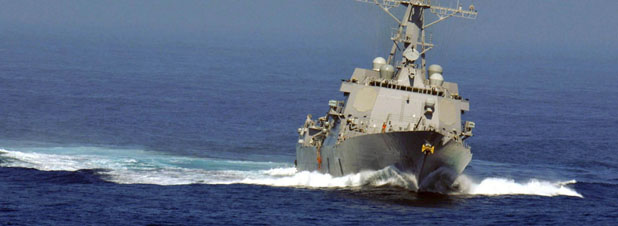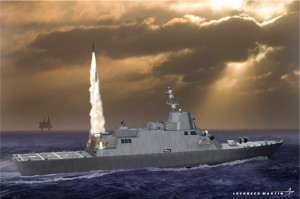 Back in March our readers voted on topics they’d like us to cover for a week of analysis. The winner was “Alternatives to the U.S. Navy’s DDG-51 Flight III”. Alas not many have felt comfortable venturing outside their expertise comfort zones to weigh in on the issue. Those few brave writers who did accept the challenge have an interesting week for you and hopefully some food for thought.
Back in March our readers voted on topics they’d like us to cover for a week of analysis. The winner was “Alternatives to the U.S. Navy’s DDG-51 Flight III”. Alas not many have felt comfortable venturing outside their expertise comfort zones to weigh in on the issue. Those few brave writers who did accept the challenge have an interesting week for you and hopefully some food for thought.
The Arleigh Burke-class (DDG-51) first entered service in 1991 as the first “Aegis destroyer” – a multi-role combatant but notably synonymous with its anti-air warfare (AAW) radar. In 1998 the ship class morphed to the Flight II with USS Mahan (DDG-72), and has since DDG-79 used evolving variations of the USS Oscar Austin Flight IIA design. With the looming retirement of the U.S. cruisers and increasing AAW and ballistic missile defense (BMD) requirements, the U.S. Navy began planning for a tentatively named CG(X) cruiser ship class to fill the role (or integrated air and missile defense (IAMD) gap) with “a new and more capable radar called the Air and Missile Defense Radar (AMDR).” However, in 2010 it opted for the DDG-51 Flight III with a “smaller and less powerful [AMDR] than the one envisaged for the CG(X)” as it was deemed cheaper to continue building on the DDG-51 frame.
As part of his coverage of the Navy’s FY13 budget submission, Ron O’Rourke at the Congressional Research Service (CRS) in late March detailed in a very readable report the Navy’s intended program of record. As he states:
“The Navy wants to begin procuring a new version of the DDG-51 design, called the Flight III design, starting with the second of the two ships scheduled for procurement in FY2016. The two DDG-51s scheduled for procurement in FY2017 are also to be of the Flight III design… The Navy for FY2013 is requesting congressional approval to use a multiyear procurement (MYP) arrangement for the nine DDG-51s scheduled for procurement in FY2013-FY2017.”
Some of the issues outlined in the CRS report (pg 18) include:
- Whether there is an adequate analytical basis for procuring Flight III DDG-51s in lieu of the previously planned CG(X) cruiser
- Whether the Flight III DDG-51 would have sufficient air and missile capability to adequately perform future air and missile defense missions
- Cost, schedule, and technical risk in the Flight III DDG-51 program
- Whether the Flight III DDG-51 design would have sufficient growth margin for a projected 35- or 40-year service life
To these unresolved points follow several more foundational questions:
- Is the AMDR the right radar to fill the U.S. Navy’s future IAMD needs?
- Is the DDG-51 the right shipframe to house the future IAMD radar, whether or not the AMDR? (in essence a roll-up of Ron’s 2nd and 4th points above). This question is especially salient in light of the reliance on the Arleigh Burke class to fill a multitude of roles beyond IAMD.
- Is there another way to do AAW and/or BMD in the time frame for the procurement and service life of the Flight III?
- Is there a way to divest the Flight IIIs of some of the other mission areas that they perform? How could this alter the distribution of ship numbers?
- Is there are a way to change the assumptions the IAMD requirements are based on?
These are the questions we don’t expect to answer conclusively, but to use as starting points to offer possibilities. For another good take on the issues, check out friend-of-the-blog Bryan McGrath’s article at USNI News.



